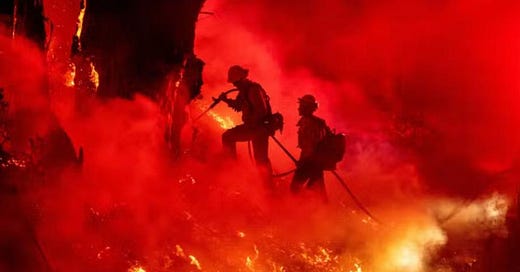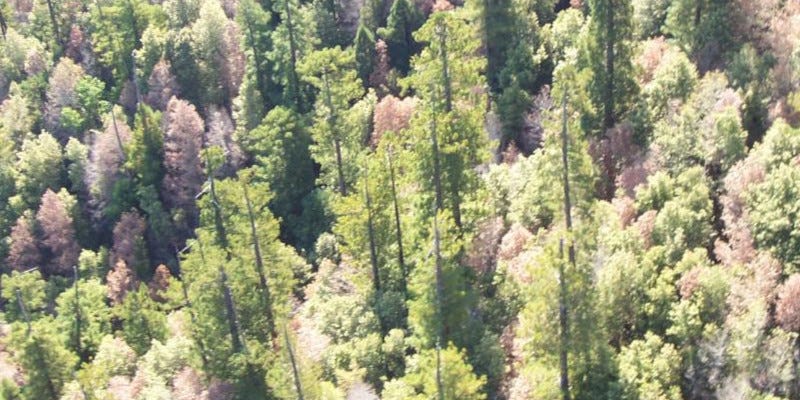Forest offsets go up in smoke in California’s “forever fire”
A key part of California’s cap-and-trade scheme relies on offsets from the state’s forests. But fires in California are devastating its forests. ProPublica described the fires as “California’s Forever Fire” in an article co-published by The New York Times Magazine earlier this year.
ProPublica’s journalist Elizabeth Weil writes about the fires that happened in 2000:
Living in California now meant accepting that fire was no longer an episodic hazard, like earthquakes. Wildfire was a constant, with us everywhere, every day, all year long, like tinnitus or regret. The dry spring was bad; the dry summer, worse; the dry fall, unbearable. Even a wet winter (if we caught a break from the drought) offered little reprieve. All thoughts, all phenomena, existed relative to fire. Where we are now — January, the fresh and less fire-alarming time of year — should be the moment for us to relax and reassess what we’re doing in California and how to live here well. Yet the rains turn the burn scars into mudslides and allow the next season’s flora, what the foresters call fuel, to grow.
Buffer pool fails to account for increased fire risk
The state of California created a “buffer pool” of offsets, as an insurance in case a forest that generates carbon offsets ends up burning down. But a new study published in Frontiers in Forests and Global Change reveals that,
California’s buffer pool makes no effort to account for the all-but-inevitable increase in fire risks as the Earth continues to warm. Nor does the program account for geographic variation in fire risks — forests in upstate New York are evaluated using the same risk reversal ratings that apply to forests in the arid American West. Failure to acknowledge the increasing risk of wildfire means that California’s forest buffer pool is likely to experience mounting losses that far exceed its design criteria in the years and decades to come.
In a statement about the study, Oriana Chegwidden of CarbonPlan, a co-author of the study, says that, “In just 10 years, wildfires have exhausted protections designed to last for a century. It is incredibly unlikely that the program will be able to withstand the wildfires of the next 90 years.”
And CarbonPlan’s Danny Cullenward, also a co-author, explains the problem that trees only store carbon temporarily:
“Fossil CO₂ emissions have permanent consequences, but carbon stored in trees won’t last forever. Forests face a wide variety of risks, including drought, disease, and — as the last few years in the American west have made painfully clear — wildfires.”
Fundamental design problem
The statement points out that,
The study shows a fundamental design problem with California’s forest carbon offset program. The climate crisis is accelerating and intensifying risks such as wildfires, diseases, and droughts. From the results, it looks like California’s buffer pool is not prepared to deal with such risks.
In 2015 and 2018, fires damaged two forest projects. As a result, more than 1 million buffer pool offsets were cancelled. About 6 million are in the buffer pool as an insurance against fires. CarbonPlan estimates that fires in 2020 and 2021 released between 4.6 and 5.7 million tonnes of carbon. That would use up all the remaining fire risk offsets in the buffer pool.
Sudden oak death
It gets worse. Fire isn’t the only risk to forests. A disease called sudden oak death has killed large areas of forest on the west coast of the USA. The study found that an outbreak of the disease in carbon projects with trees at danger to the disease could wipe out the offsets in the buffer pool for disease and insect risks.
The study states that,
[T]he potential carbon losses associated with a single disease (sudden oak death) and its impacts on a single species (tanoak) is large enough to fully encumber the total credits set aside for all disease- and insect-related mortality over 100 years.
Carbon offsets don’t deliver
The California Air Resources Board told Vice that the size of the buffer pool was calculated on “the best information available” at the time the system was developed. The CARB promised to assess “new information” at its next update.
The problems highlighted in this study are not limited to California. As CarbonPlan’s Freya Chay notes, “The problems we observe here aren’t unique to the California program and raise broader concerns about the integrity of offsets’ permanence claims.”
Cullenward comments that,
“More and more companies and governments are using ‘nature-based’ offsets to market consumer-facing claims. While there are many good reasons to invest in forest health and conservation, forest carbon offsets don’t deliver climate benefits that justify ongoing fossil CO₂ emissions.”








